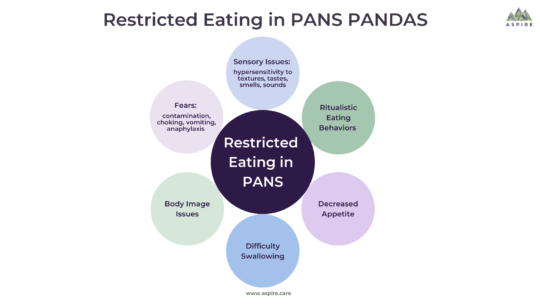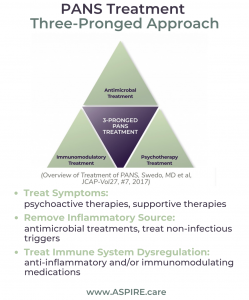
PANS & Eating Disorder/Food Restrictions & Toolkits/Handouts
PANS PANDAS & Eating Disorders/Food Restrictions – Full Packet of Recent studies and Flyer. Please note that the Flyer is also available in two poster sizes...
PANS Consensus Statement on Diagnosing PANS and PANDAS –Clinical Evaluation of Youth with Pediatric Acute-Onset Neuropsychiatric Syndrome (PANS): Recommendations from the 2013 PANS Consensus Conference. Chang, MD et al (JCAP, Vol 25, No 1, 2015 Mary Ann Liebert, Inc.)
PANS PANDAS Symptoms PANS Consensus Statement
More on the PANS Diagnostic Process
The PANDAS Physicians Network (PPN) flowcharts for diagnosis and treatment will help clinicians evaluate their patients and determine the best course of treatment. Guidelines and workflows were approved by practitioners of the PANDAS Physicians Network Scientific Advisory Board. More detailed resources are available at www.pandasppn.org. Diagnosing and treating should be done by a licensed healthcare provider.
Primary care providers play important, ongoing roles in the diagnosis, treatment, and recovery of children with PANS/PANDAS. Children with a moderate or severe/life-threatening onset or a complex presentation may require treatment by an experienced multi-disciplinary team of specialists or a PANS/PANDAS specialist. Additional resources can be found at
PANS treatment utilizes three complementary modes of interventions to treat the patient completely. Three-pronged treatment protocols are dependent on disease trajectory, symptoms, and severity as well as lab work and patient history.

JCAP PANS Treatment Guidelines
The PANDAS Physicians Network (PPN) flowcharts for diagnosis and treatment will help clinicians evaluate their patients and determine the best course of treatment. The diagnostic flowchart and treatment guidelines include a detailed process provided for determining the appropriate diagnosis and symptom severity-based treatment protocols for mild, moderate, and severe/extreme cases.
Download PPN Treatment Flowchart
 PANS PANDAS Clinician Toolkit
PANS PANDAS Clinician ToolkitThere are invaluable resources to help clinicians learn how to recognize PANS PANDAS symptoms, do a workup to inform a possible diagnosis, and create a treatment plan. ASPIRE has assembled this one-page Clinician Toolkit but there are many resources throughout the website, and we are always adding more. So, check the website often.
 Diagnosis & Treatment of PANS PANDAS – Provider Packet
Diagnosis & Treatment of PANS PANDAS – Provider PacketClick the button below to download the twelve-page information packet Provider Information on PANS PANDAS, including Symptoms, Diagnosis, and Treatment.
 PANS PANDAS Guidelines for Children with Autism
PANS PANDAS Guidelines for Children with Autism
 Testing & Antibiotic Usage for GAS in PANS & PANDAS
Testing & Antibiotic Usage for GAS in PANS & PANDASASPIRE’S Professional Advisory Board Toolkit:
PANS is a clinical condition identified by an abrupt onset of a specific cluster of symptoms as a result of a variety of etiologies and disease mechanisms. Therefore, tracking symptoms, onset, severity, and duration is a critical part of making a clinical diagnosis and forming treatment plans. There are two useful PANS Symptom Rating Scale tools.

Developed by Tanya Murphy, MD and Gail Bernstein, MD. Source: PANS/PANDAS: CLINICAL & RESEARCH UPDATE, Gail A. Bernstein, M.D., 12/9/16, University of Minnesota
You can scroll through the pages of the Clinician Resources below. However, clicking on the link to the main Clinician Resources page is easier. Otherwise, you will be redirected to the top of this page each time you scroll to a secondary page in the resources.

PANS PANDAS & Eating Disorders/Food Restrictions – Full Packet of Recent studies and Flyer. Please note that the Flyer is also available in two poster sizes...

Nutrition is vital for kids with PANS/PANDAS, conditions tied to OCD and infections like strep that disrupt eating habits, causing nutrient deficiencies and gut issues. Registered Dietitians (RDs)...

Living with a sibling affected by PANS profoundly impacts well-being—fear of outbursts, limited social opportunities, and the isolation of not having the words or knowledge to explain the...

Staying well-hydrated before, during, and after IVIG can help minimize side effects like headaches, dizziness, fatigue, and muscle cramps. Here’s how to make hydration work for you: Download...

ASPIRE to Speak at NJSSNA Spring 2025 Conference – Pearls of Wisdom for School Nurses Conference Details Friday, March 28, 2025 at 6:00pm ET – Saturday, March 29,...

Clinic Providers & Healthcare Workers – Join Us at the MAPS Spring 2025 Functional & Translational Medicine Conference Register using the ASPIRE discount code and enjoy a 30% discount!...

ASPIRE and other PANS/PANDAS organizations are joining the PANDAS Physician Network in their efforts to call to the Academy of Pediatrics to update the Red Book’s® recently published...

ASPIRE’S Professional Advisory Board publishes PANS/PANDAS Guidelines for Children with Autism PANS PANDAS & Autism Autism PANS Guidelines Children who have autism spectrum disorder (ASD or...

GRAND ROUNDS – Register Today Children’s Minnesota will host a one-hour pediatric grand rounds presentation featuring Eyal Muscal, MD, MS. – Neuroinflammation in Children: Breaking...

Certain dental procedures can increase the risk of bacteremia (the presence of viable bacteria in the circulating blood).¹ Thus, the American Heart Association’s 2007 guidelines recommend...

If the embedded video link does not play on this page, please watch directly on YouTube. Symposiums ASPIRE was invited by the Associazione Genitori Pans Pandas Bge Organizzazione...

Inflammatory Brain Disorders in Psychological Practice: A Focus on Pediatric Acute-Onset Neuropsychiatric Syndrome Sunday, May 7th, 10:00 AM – 12:30 PM Pacific Time Presented by Zoe...